Case Study Analysis: Caring Behaviors in Nursing Practice (NUR1100)
VerifiedAdded on 2022/09/06
|8
|2137
|19
Case Study
AI Summary
This case study analyzes the caring behaviors exhibited by a nurse in a patient interaction, focusing on attentive listening, responsibility, providing information, and the use of touch and comfort. The study examines how these behaviors align with Jean Watson's theory of human caring, emphasizing health promotion, patient acceptance, and the creation of a supportive environment. The nurse's actions are evaluated in terms of their impact on patient care, including the application of the six C's of caring. The case highlights the importance of professional nursing behaviors and patient-centered care, underscoring the role of compassion and ethical considerations in addressing the patient's needs. References to relevant literature support the analysis, providing context for the application of caring behaviors and their impact on patient outcomes.

1
Aaqib Abbas Case Study
Student’s Name
University
Aaqib Abbas Case Study
Student’s Name
University
Paraphrase This Document
Need a fresh take? Get an instant paraphrase of this document with our AI Paraphraser
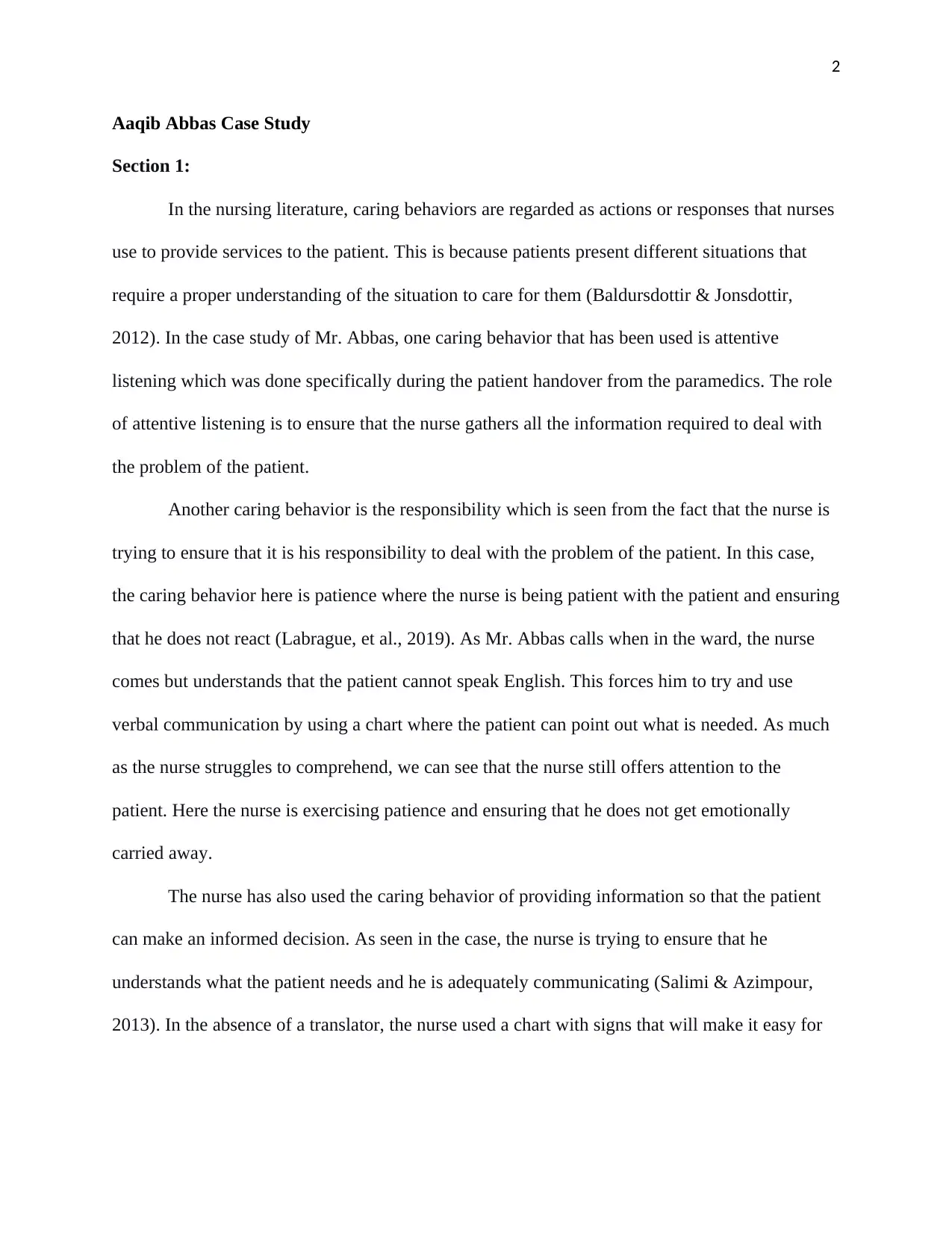
2
Aaqib Abbas Case Study
Section 1:
In the nursing literature, caring behaviors are regarded as actions or responses that nurses
use to provide services to the patient. This is because patients present different situations that
require a proper understanding of the situation to care for them (Baldursdottir & Jonsdottir,
2012). In the case study of Mr. Abbas, one caring behavior that has been used is attentive
listening which was done specifically during the patient handover from the paramedics. The role
of attentive listening is to ensure that the nurse gathers all the information required to deal with
the problem of the patient.
Another caring behavior is the responsibility which is seen from the fact that the nurse is
trying to ensure that it is his responsibility to deal with the problem of the patient. In this case,
the caring behavior here is patience where the nurse is being patient with the patient and ensuring
that he does not react (Labrague, et al., 2019). As Mr. Abbas calls when in the ward, the nurse
comes but understands that the patient cannot speak English. This forces him to try and use
verbal communication by using a chart where the patient can point out what is needed. As much
as the nurse struggles to comprehend, we can see that the nurse still offers attention to the
patient. Here the nurse is exercising patience and ensuring that he does not get emotionally
carried away.
The nurse has also used the caring behavior of providing information so that the patient
can make an informed decision. As seen in the case, the nurse is trying to ensure that he
understands what the patient needs and he is adequately communicating (Salimi & Azimpour,
2013). In the absence of a translator, the nurse used a chart with signs that will make it easy for
Aaqib Abbas Case Study
Section 1:
In the nursing literature, caring behaviors are regarded as actions or responses that nurses
use to provide services to the patient. This is because patients present different situations that
require a proper understanding of the situation to care for them (Baldursdottir & Jonsdottir,
2012). In the case study of Mr. Abbas, one caring behavior that has been used is attentive
listening which was done specifically during the patient handover from the paramedics. The role
of attentive listening is to ensure that the nurse gathers all the information required to deal with
the problem of the patient.
Another caring behavior is the responsibility which is seen from the fact that the nurse is
trying to ensure that it is his responsibility to deal with the problem of the patient. In this case,
the caring behavior here is patience where the nurse is being patient with the patient and ensuring
that he does not react (Labrague, et al., 2019). As Mr. Abbas calls when in the ward, the nurse
comes but understands that the patient cannot speak English. This forces him to try and use
verbal communication by using a chart where the patient can point out what is needed. As much
as the nurse struggles to comprehend, we can see that the nurse still offers attention to the
patient. Here the nurse is exercising patience and ensuring that he does not get emotionally
carried away.
The nurse has also used the caring behavior of providing information so that the patient
can make an informed decision. As seen in the case, the nurse is trying to ensure that he
understands what the patient needs and he is adequately communicating (Salimi & Azimpour,
2013). In the absence of a translator, the nurse used a chart with signs that will make it easy for
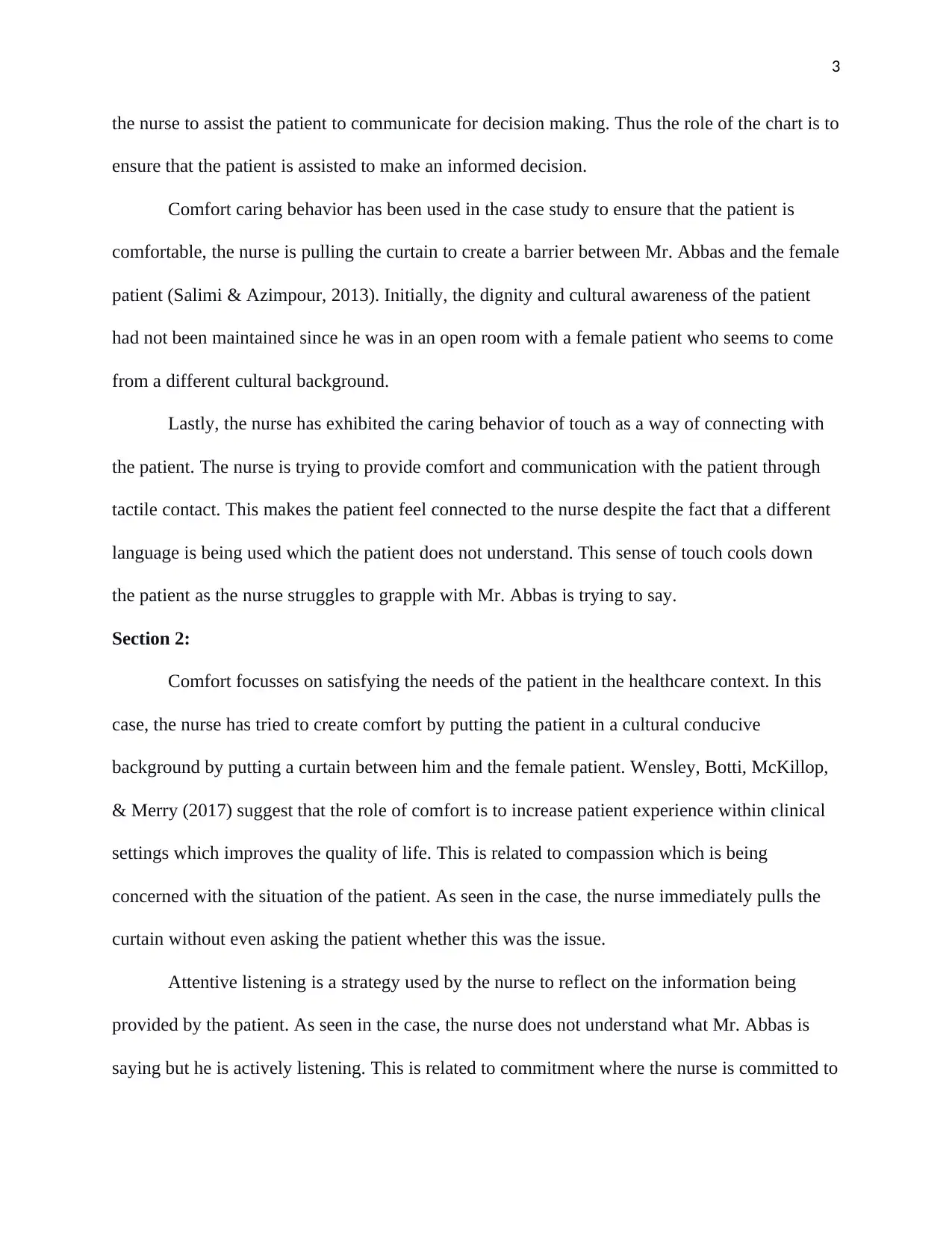
3
the nurse to assist the patient to communicate for decision making. Thus the role of the chart is to
ensure that the patient is assisted to make an informed decision.
Comfort caring behavior has been used in the case study to ensure that the patient is
comfortable, the nurse is pulling the curtain to create a barrier between Mr. Abbas and the female
patient (Salimi & Azimpour, 2013). Initially, the dignity and cultural awareness of the patient
had not been maintained since he was in an open room with a female patient who seems to come
from a different cultural background.
Lastly, the nurse has exhibited the caring behavior of touch as a way of connecting with
the patient. The nurse is trying to provide comfort and communication with the patient through
tactile contact. This makes the patient feel connected to the nurse despite the fact that a different
language is being used which the patient does not understand. This sense of touch cools down
the patient as the nurse struggles to grapple with Mr. Abbas is trying to say.
Section 2:
Comfort focusses on satisfying the needs of the patient in the healthcare context. In this
case, the nurse has tried to create comfort by putting the patient in a cultural conducive
background by putting a curtain between him and the female patient. Wensley, Botti, McKillop,
& Merry (2017) suggest that the role of comfort is to increase patient experience within clinical
settings which improves the quality of life. This is related to compassion which is being
concerned with the situation of the patient. As seen in the case, the nurse immediately pulls the
curtain without even asking the patient whether this was the issue.
Attentive listening is a strategy used by the nurse to reflect on the information being
provided by the patient. As seen in the case, the nurse does not understand what Mr. Abbas is
saying but he is actively listening. This is related to commitment where the nurse is committed to
the nurse to assist the patient to communicate for decision making. Thus the role of the chart is to
ensure that the patient is assisted to make an informed decision.
Comfort caring behavior has been used in the case study to ensure that the patient is
comfortable, the nurse is pulling the curtain to create a barrier between Mr. Abbas and the female
patient (Salimi & Azimpour, 2013). Initially, the dignity and cultural awareness of the patient
had not been maintained since he was in an open room with a female patient who seems to come
from a different cultural background.
Lastly, the nurse has exhibited the caring behavior of touch as a way of connecting with
the patient. The nurse is trying to provide comfort and communication with the patient through
tactile contact. This makes the patient feel connected to the nurse despite the fact that a different
language is being used which the patient does not understand. This sense of touch cools down
the patient as the nurse struggles to grapple with Mr. Abbas is trying to say.
Section 2:
Comfort focusses on satisfying the needs of the patient in the healthcare context. In this
case, the nurse has tried to create comfort by putting the patient in a cultural conducive
background by putting a curtain between him and the female patient. Wensley, Botti, McKillop,
& Merry (2017) suggest that the role of comfort is to increase patient experience within clinical
settings which improves the quality of life. This is related to compassion which is being
concerned with the situation of the patient. As seen in the case, the nurse immediately pulls the
curtain without even asking the patient whether this was the issue.
Attentive listening is a strategy used by the nurse to reflect on the information being
provided by the patient. As seen in the case, the nurse does not understand what Mr. Abbas is
saying but he is actively listening. This is related to commitment where the nurse is committed to
⊘ This is a preview!⊘
Do you want full access?
Subscribe today to unlock all pages.

Trusted by 1+ million students worldwide
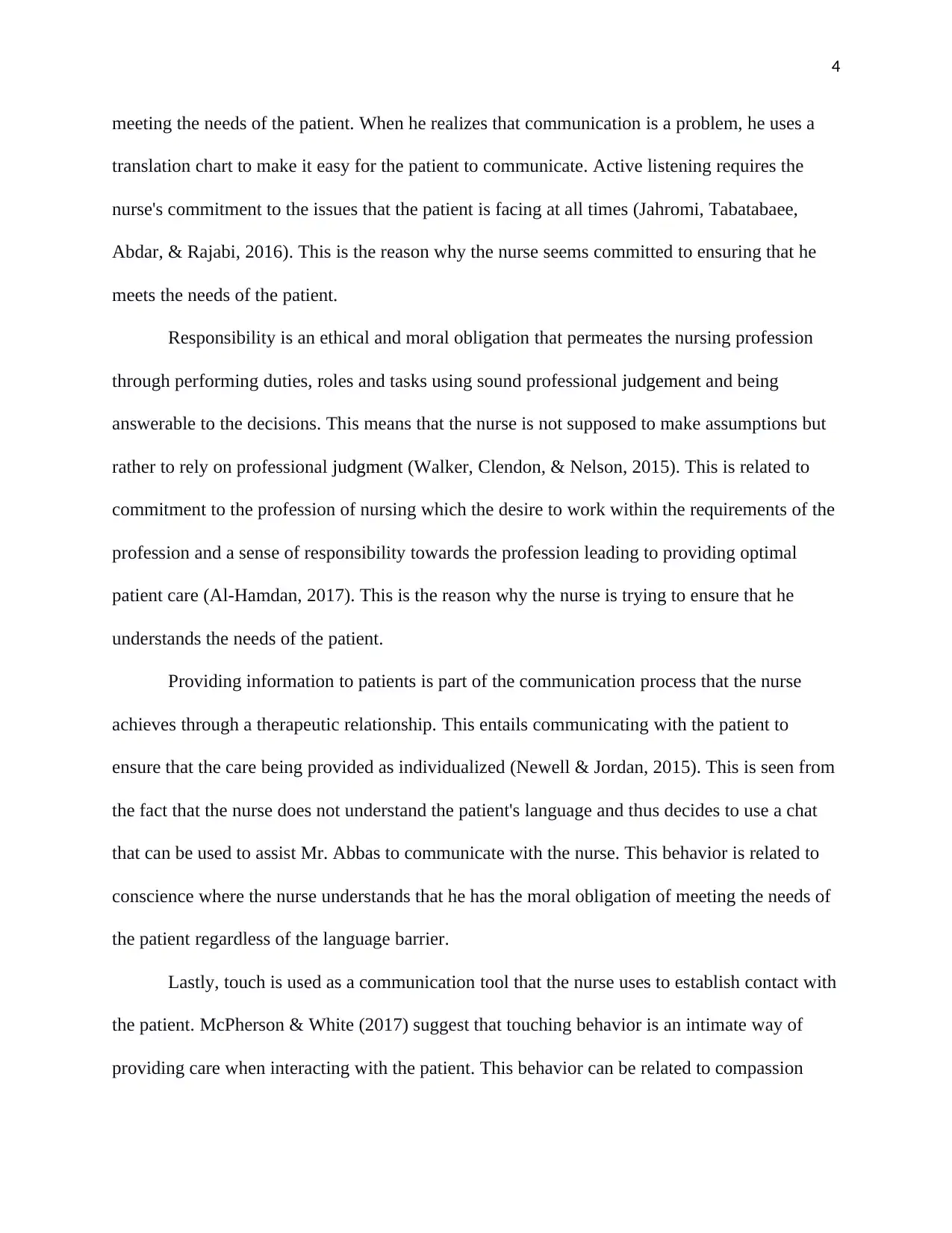
4
meeting the needs of the patient. When he realizes that communication is a problem, he uses a
translation chart to make it easy for the patient to communicate. Active listening requires the
nurse's commitment to the issues that the patient is facing at all times (Jahromi, Tabatabaee,
Abdar, & Rajabi, 2016). This is the reason why the nurse seems committed to ensuring that he
meets the needs of the patient.
Responsibility is an ethical and moral obligation that permeates the nursing profession
through performing duties, roles and tasks using sound professional judgement and being
answerable to the decisions. This means that the nurse is not supposed to make assumptions but
rather to rely on professional judgment (Walker, Clendon, & Nelson, 2015). This is related to
commitment to the profession of nursing which the desire to work within the requirements of the
profession and a sense of responsibility towards the profession leading to providing optimal
patient care (Al-Hamdan, 2017). This is the reason why the nurse is trying to ensure that he
understands the needs of the patient.
Providing information to patients is part of the communication process that the nurse
achieves through a therapeutic relationship. This entails communicating with the patient to
ensure that the care being provided as individualized (Newell & Jordan, 2015). This is seen from
the fact that the nurse does not understand the patient's language and thus decides to use a chat
that can be used to assist Mr. Abbas to communicate with the nurse. This behavior is related to
conscience where the nurse understands that he has the moral obligation of meeting the needs of
the patient regardless of the language barrier.
Lastly, touch is used as a communication tool that the nurse uses to establish contact with
the patient. McPherson & White (2017) suggest that touching behavior is an intimate way of
providing care when interacting with the patient. This behavior can be related to compassion
meeting the needs of the patient. When he realizes that communication is a problem, he uses a
translation chart to make it easy for the patient to communicate. Active listening requires the
nurse's commitment to the issues that the patient is facing at all times (Jahromi, Tabatabaee,
Abdar, & Rajabi, 2016). This is the reason why the nurse seems committed to ensuring that he
meets the needs of the patient.
Responsibility is an ethical and moral obligation that permeates the nursing profession
through performing duties, roles and tasks using sound professional judgement and being
answerable to the decisions. This means that the nurse is not supposed to make assumptions but
rather to rely on professional judgment (Walker, Clendon, & Nelson, 2015). This is related to
commitment to the profession of nursing which the desire to work within the requirements of the
profession and a sense of responsibility towards the profession leading to providing optimal
patient care (Al-Hamdan, 2017). This is the reason why the nurse is trying to ensure that he
understands the needs of the patient.
Providing information to patients is part of the communication process that the nurse
achieves through a therapeutic relationship. This entails communicating with the patient to
ensure that the care being provided as individualized (Newell & Jordan, 2015). This is seen from
the fact that the nurse does not understand the patient's language and thus decides to use a chat
that can be used to assist Mr. Abbas to communicate with the nurse. This behavior is related to
conscience where the nurse understands that he has the moral obligation of meeting the needs of
the patient regardless of the language barrier.
Lastly, touch is used as a communication tool that the nurse uses to establish contact with
the patient. McPherson & White (2017) suggest that touching behavior is an intimate way of
providing care when interacting with the patient. This behavior can be related to compassion
Paraphrase This Document
Need a fresh take? Get an instant paraphrase of this document with our AI Paraphraser
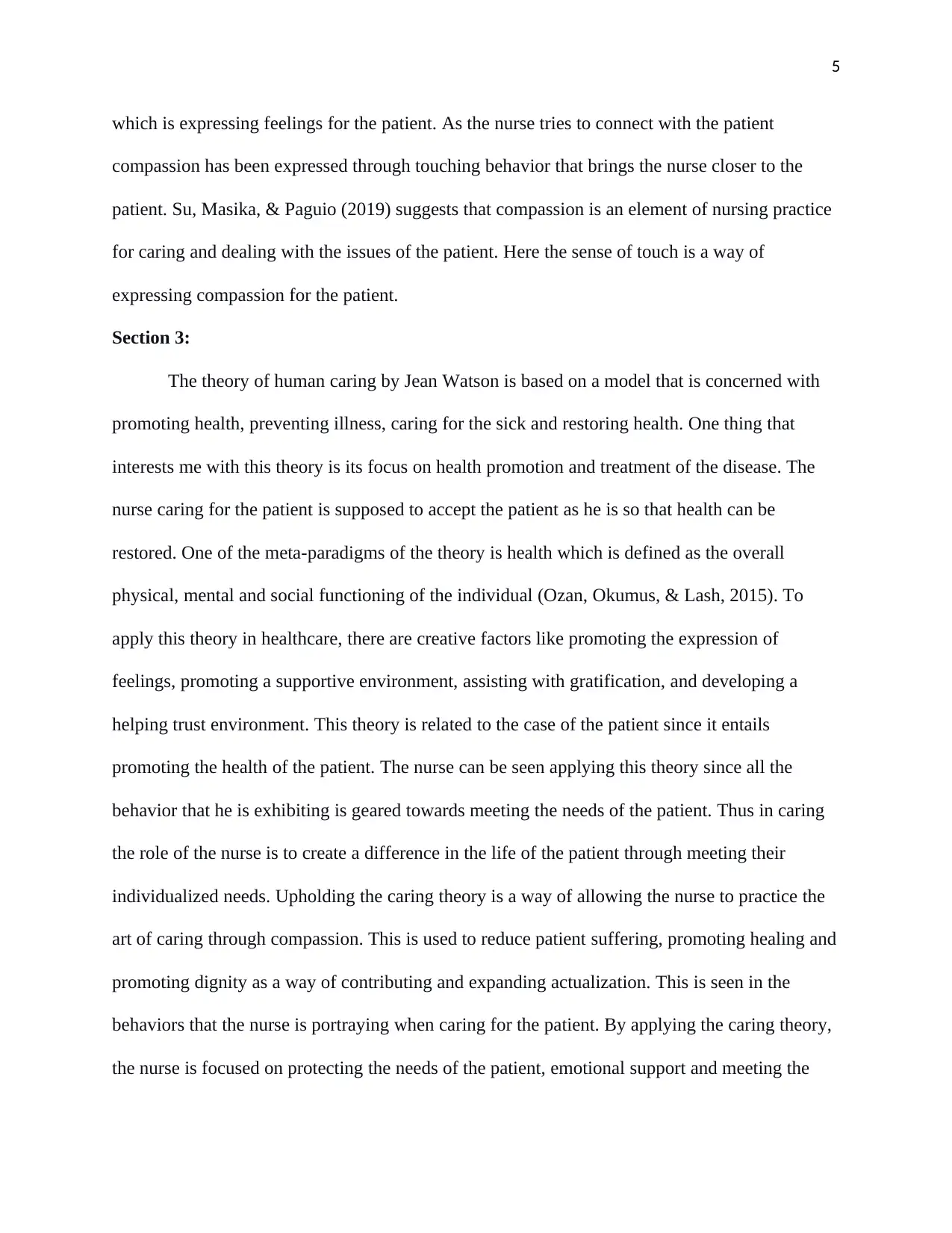
5
which is expressing feelings for the patient. As the nurse tries to connect with the patient
compassion has been expressed through touching behavior that brings the nurse closer to the
patient. Su, Masika, & Paguio (2019) suggests that compassion is an element of nursing practice
for caring and dealing with the issues of the patient. Here the sense of touch is a way of
expressing compassion for the patient.
Section 3:
The theory of human caring by Jean Watson is based on a model that is concerned with
promoting health, preventing illness, caring for the sick and restoring health. One thing that
interests me with this theory is its focus on health promotion and treatment of the disease. The
nurse caring for the patient is supposed to accept the patient as he is so that health can be
restored. One of the meta-paradigms of the theory is health which is defined as the overall
physical, mental and social functioning of the individual (Ozan, Okumus, & Lash, 2015). To
apply this theory in healthcare, there are creative factors like promoting the expression of
feelings, promoting a supportive environment, assisting with gratification, and developing a
helping trust environment. This theory is related to the case of the patient since it entails
promoting the health of the patient. The nurse can be seen applying this theory since all the
behavior that he is exhibiting is geared towards meeting the needs of the patient. Thus in caring
the role of the nurse is to create a difference in the life of the patient through meeting their
individualized needs. Upholding the caring theory is a way of allowing the nurse to practice the
art of caring through compassion. This is used to reduce patient suffering, promoting healing and
promoting dignity as a way of contributing and expanding actualization. This is seen in the
behaviors that the nurse is portraying when caring for the patient. By applying the caring theory,
the nurse is focused on protecting the needs of the patient, emotional support and meeting the
which is expressing feelings for the patient. As the nurse tries to connect with the patient
compassion has been expressed through touching behavior that brings the nurse closer to the
patient. Su, Masika, & Paguio (2019) suggests that compassion is an element of nursing practice
for caring and dealing with the issues of the patient. Here the sense of touch is a way of
expressing compassion for the patient.
Section 3:
The theory of human caring by Jean Watson is based on a model that is concerned with
promoting health, preventing illness, caring for the sick and restoring health. One thing that
interests me with this theory is its focus on health promotion and treatment of the disease. The
nurse caring for the patient is supposed to accept the patient as he is so that health can be
restored. One of the meta-paradigms of the theory is health which is defined as the overall
physical, mental and social functioning of the individual (Ozan, Okumus, & Lash, 2015). To
apply this theory in healthcare, there are creative factors like promoting the expression of
feelings, promoting a supportive environment, assisting with gratification, and developing a
helping trust environment. This theory is related to the case of the patient since it entails
promoting the health of the patient. The nurse can be seen applying this theory since all the
behavior that he is exhibiting is geared towards meeting the needs of the patient. Thus in caring
the role of the nurse is to create a difference in the life of the patient through meeting their
individualized needs. Upholding the caring theory is a way of allowing the nurse to practice the
art of caring through compassion. This is used to reduce patient suffering, promoting healing and
promoting dignity as a way of contributing and expanding actualization. This is seen in the
behaviors that the nurse is portraying when caring for the patient. By applying the caring theory,
the nurse is focused on protecting the needs of the patient, emotional support and meeting the
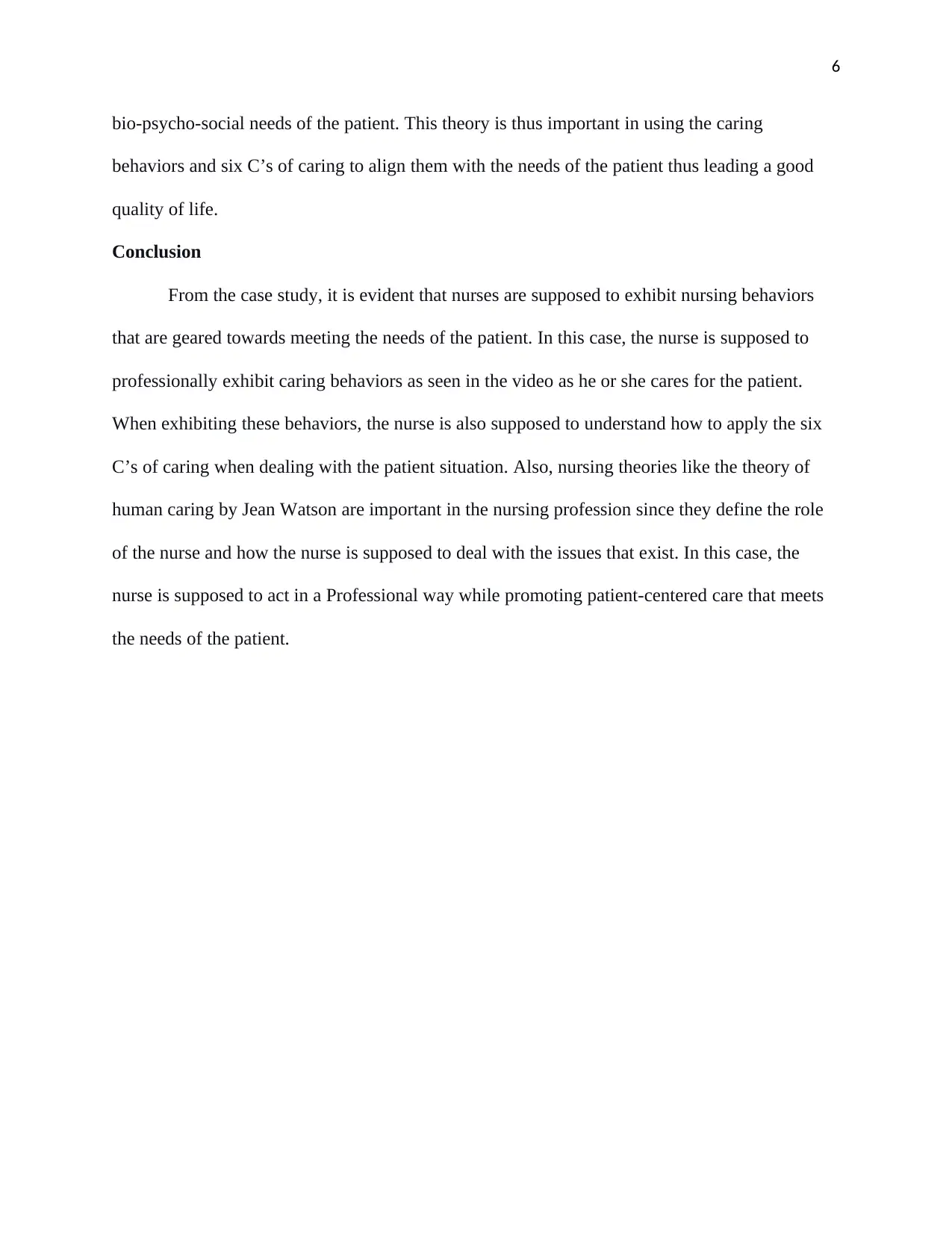
6
bio-psycho-social needs of the patient. This theory is thus important in using the caring
behaviors and six C’s of caring to align them with the needs of the patient thus leading a good
quality of life.
Conclusion
From the case study, it is evident that nurses are supposed to exhibit nursing behaviors
that are geared towards meeting the needs of the patient. In this case, the nurse is supposed to
professionally exhibit caring behaviors as seen in the video as he or she cares for the patient.
When exhibiting these behaviors, the nurse is also supposed to understand how to apply the six
C’s of caring when dealing with the patient situation. Also, nursing theories like the theory of
human caring by Jean Watson are important in the nursing profession since they define the role
of the nurse and how the nurse is supposed to deal with the issues that exist. In this case, the
nurse is supposed to act in a Professional way while promoting patient-centered care that meets
the needs of the patient.
bio-psycho-social needs of the patient. This theory is thus important in using the caring
behaviors and six C’s of caring to align them with the needs of the patient thus leading a good
quality of life.
Conclusion
From the case study, it is evident that nurses are supposed to exhibit nursing behaviors
that are geared towards meeting the needs of the patient. In this case, the nurse is supposed to
professionally exhibit caring behaviors as seen in the video as he or she cares for the patient.
When exhibiting these behaviors, the nurse is also supposed to understand how to apply the six
C’s of caring when dealing with the patient situation. Also, nursing theories like the theory of
human caring by Jean Watson are important in the nursing profession since they define the role
of the nurse and how the nurse is supposed to deal with the issues that exist. In this case, the
nurse is supposed to act in a Professional way while promoting patient-centered care that meets
the needs of the patient.
⊘ This is a preview!⊘
Do you want full access?
Subscribe today to unlock all pages.

Trusted by 1+ million students worldwide
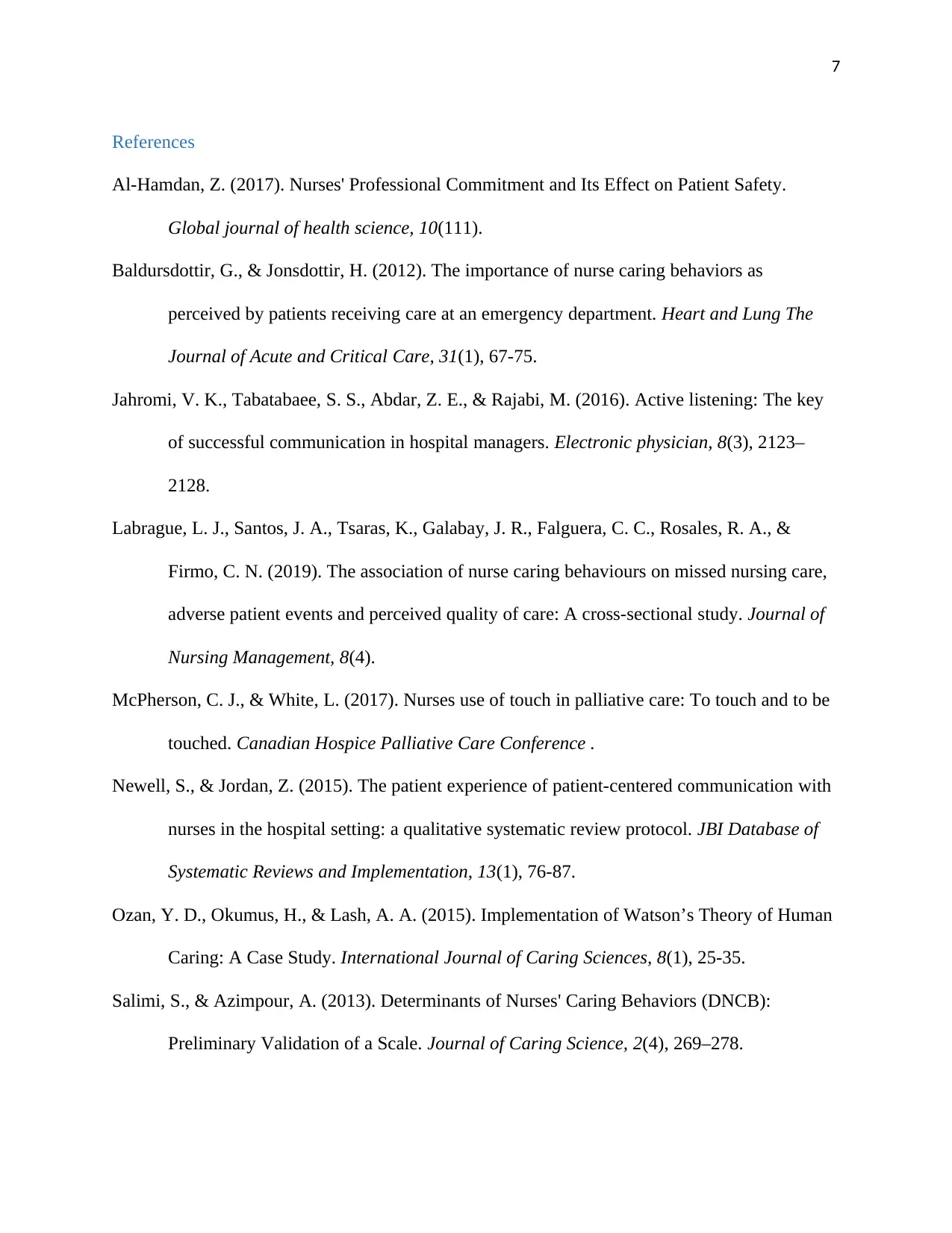
7
References
Al-Hamdan, Z. (2017). Nurses' Professional Commitment and Its Effect on Patient Safety.
Global journal of health science, 10(111).
Baldursdottir, G., & Jonsdottir, H. (2012). The importance of nurse caring behaviors as
perceived by patients receiving care at an emergency department. Heart and Lung The
Journal of Acute and Critical Care, 31(1), 67-75.
Jahromi, V. K., Tabatabaee, S. S., Abdar, Z. E., & Rajabi, M. (2016). Active listening: The key
of successful communication in hospital managers. Electronic physician, 8(3), 2123–
2128.
Labrague, L. J., Santos, J. A., Tsaras, K., Galabay, J. R., Falguera, C. C., Rosales, R. A., &
Firmo, C. N. (2019). The association of nurse caring behaviours on missed nursing care,
adverse patient events and perceived quality of care: A cross‐sectional study. Journal of
Nursing Management, 8(4).
McPherson, C. J., & White, L. (2017). Nurses use of touch in palliative care: To touch and to be
touched. Canadian Hospice Palliative Care Conference .
Newell, S., & Jordan, Z. (2015). The patient experience of patient-centered communication with
nurses in the hospital setting: a qualitative systematic review protocol. JBI Database of
Systematic Reviews and Implementation, 13(1), 76-87.
Ozan, Y. D., Okumus, H., & Lash, A. A. (2015). Implementation of Watson’s Theory of Human
Caring: A Case Study. International Journal of Caring Sciences, 8(1), 25-35.
Salimi, S., & Azimpour, A. (2013). Determinants of Nurses' Caring Behaviors (DNCB):
Preliminary Validation of a Scale. Journal of Caring Science, 2(4), 269–278.
References
Al-Hamdan, Z. (2017). Nurses' Professional Commitment and Its Effect on Patient Safety.
Global journal of health science, 10(111).
Baldursdottir, G., & Jonsdottir, H. (2012). The importance of nurse caring behaviors as
perceived by patients receiving care at an emergency department. Heart and Lung The
Journal of Acute and Critical Care, 31(1), 67-75.
Jahromi, V. K., Tabatabaee, S. S., Abdar, Z. E., & Rajabi, M. (2016). Active listening: The key
of successful communication in hospital managers. Electronic physician, 8(3), 2123–
2128.
Labrague, L. J., Santos, J. A., Tsaras, K., Galabay, J. R., Falguera, C. C., Rosales, R. A., &
Firmo, C. N. (2019). The association of nurse caring behaviours on missed nursing care,
adverse patient events and perceived quality of care: A cross‐sectional study. Journal of
Nursing Management, 8(4).
McPherson, C. J., & White, L. (2017). Nurses use of touch in palliative care: To touch and to be
touched. Canadian Hospice Palliative Care Conference .
Newell, S., & Jordan, Z. (2015). The patient experience of patient-centered communication with
nurses in the hospital setting: a qualitative systematic review protocol. JBI Database of
Systematic Reviews and Implementation, 13(1), 76-87.
Ozan, Y. D., Okumus, H., & Lash, A. A. (2015). Implementation of Watson’s Theory of Human
Caring: A Case Study. International Journal of Caring Sciences, 8(1), 25-35.
Salimi, S., & Azimpour, A. (2013). Determinants of Nurses' Caring Behaviors (DNCB):
Preliminary Validation of a Scale. Journal of Caring Science, 2(4), 269–278.
Paraphrase This Document
Need a fresh take? Get an instant paraphrase of this document with our AI Paraphraser
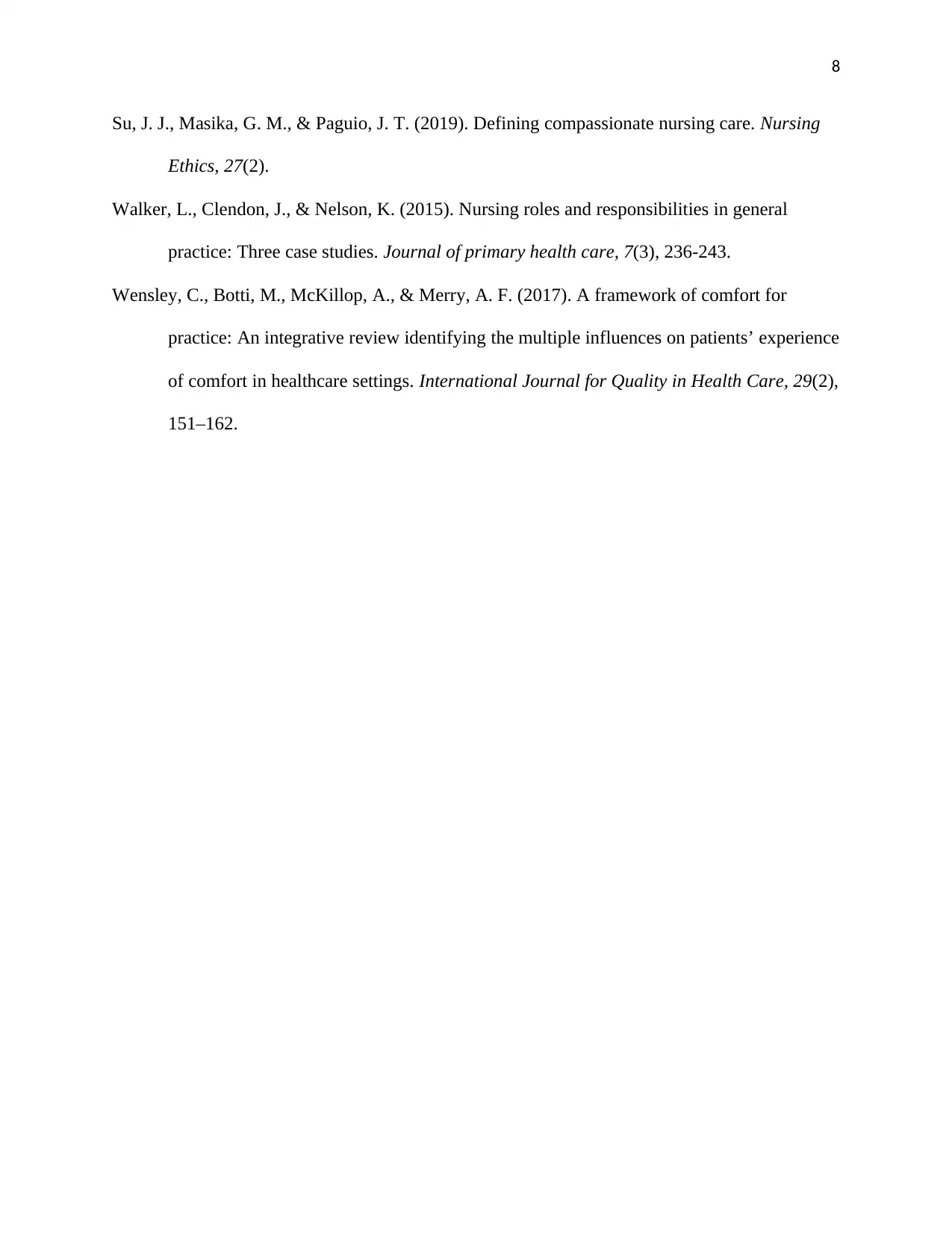
8
Su, J. J., Masika, G. M., & Paguio, J. T. (2019). Defining compassionate nursing care. Nursing
Ethics, 27(2).
Walker, L., Clendon, J., & Nelson, K. (2015). Nursing roles and responsibilities in general
practice: Three case studies. Journal of primary health care, 7(3), 236-243.
Wensley, C., Botti, M., McKillop, A., & Merry, A. F. (2017). A framework of comfort for
practice: An integrative review identifying the multiple influences on patients’ experience
of comfort in healthcare settings. International Journal for Quality in Health Care, 29(2),
151–162.
Su, J. J., Masika, G. M., & Paguio, J. T. (2019). Defining compassionate nursing care. Nursing
Ethics, 27(2).
Walker, L., Clendon, J., & Nelson, K. (2015). Nursing roles and responsibilities in general
practice: Three case studies. Journal of primary health care, 7(3), 236-243.
Wensley, C., Botti, M., McKillop, A., & Merry, A. F. (2017). A framework of comfort for
practice: An integrative review identifying the multiple influences on patients’ experience
of comfort in healthcare settings. International Journal for Quality in Health Care, 29(2),
151–162.
1 out of 8
Related Documents
Your All-in-One AI-Powered Toolkit for Academic Success.
+13062052269
info@desklib.com
Available 24*7 on WhatsApp / Email
![[object Object]](/_next/static/media/star-bottom.7253800d.svg)
Unlock your academic potential
Copyright © 2020–2025 A2Z Services. All Rights Reserved. Developed and managed by ZUCOL.





